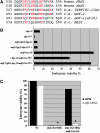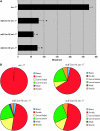Components of the spindle assembly checkpoint regulate the anaphase-promoting complex during meiosis in Caenorhabditis elegans
- PMID: 17057243
- PMCID: PMC1774991
- DOI: 10.1534/genetics.106.059105
Components of the spindle assembly checkpoint regulate the anaphase-promoting complex during meiosis in Caenorhabditis elegans
Abstract
Temperature-sensitive mutations in subunits of the Caenorhabditis elegans anaphase-promoting complex (APC) arrest at metaphase of meiosis I at the restrictive temperature. Embryos depleted of the APC co-activator FZY-1 by RNAi also arrest at this stage. To identify regulators and potential substrates of the APC, we performed a genetic suppressor screen with a weak allele of the APC subunit MAT-3/CDC23/APC8, whose defects are specific to meiosis. Twenty-seven suppressors that resulted in embryonic viability and larval development at the restrictive temperature were isolated. We have identified the molecular lesions in 18 of these suppressors, which correspond to five genes. In addition to a single intragenic suppressor, we found mutations in the APC co-activator fzy-1 and in three spindle assembly checkpoint genes, mdf-1, mdf-2, and mdf-3/san-1, orthologs of Mad1, Mad2, and Mad3, respectively. Reduction-of-function alleles of mdf-2 and mdf-3 suppress APC mutants and exhibit pleiotropic phenotypes in an otherwise wild-type background. Analysis of a single separation-of-function allele of mdf-1 suggests that MDF-1 has a dual role during development. These studies provide evidence that components of the spindle assembly checkpoint may regulate the metaphase-to-anaphase transition in the absence of spindle damage during C. elegans meiosis.
Figures







References
-
- Baker, D. J., K. B. Jeganathan, J. D. Cameron, M. Thompson, S. Juneja et al., 2004. BubR1 insufficiency causes early onset of aging-associated phenotypes and infertility in mice. Nat. Genet. 36: 744–749. - PubMed
-
- Basto, R., R. Gomes and R. E. Karess, 2000. Rough deal and Zw10 are required for the metaphase checkpoint in Drosophila. Nat. Cell Biol. 2: 939–943. - PubMed
-
- Bharadwaj, R., and H. Yu, 2004. The spindle checkpoint, aneuploidy, and cancer. Oncogene 23: 2016–2027. - PubMed
Publication types
MeSH terms
Substances
Grants and funding
LinkOut - more resources
Full Text Sources
Molecular Biology Databases
Miscellaneous

